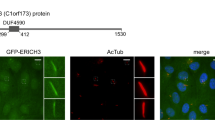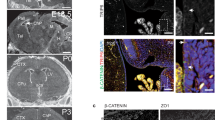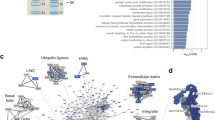Abstract
The formation and function of cilia involves the movement of intraflagellar transport (IFT) particles underneath the ciliary membrane, along axonemal microtubules1,2. Although this process has been studied extensively, its molecular basis remains incompletely understood. For example, it is unknown how the IFT particle interacts with transmembrane proteins. To study the IFT particle further, we examined elipsa, a locus characterized by mutations that cause particularly early ciliogenesis defects in zebrafish. We show here that elipsa encodes a coiled-coil polypeptide that localizes to cilia. Elipsa protein binds to Ift20, a component of IFT particles, and Elipsa homologue in Caenorhabditis elegans, DYF-11, translocates in sensory cilia, similarly to the IFT particle. This indicates that Elipsa is an IFT particle polypeptide. In the context of zebrafish embryogenesis, Elipsa interacts genetically with Rabaptin5, a well-studied regulator of endocytosis, which in turn interacts with Rab8, a small GTPase, known to localize to cilia. We show that Rabaptin5 binds to both Elipsa and Rab8, suggesting that these proteins provide a bridging mechanism between the IFT particle and protein complexes that assemble at the ciliary membrane.
This is a preview of subscription content, access via your institution
Access options
Subscribe to this journal
Receive 12 print issues and online access
$209.00 per year
only $17.42 per issue
Buy this article
- Purchase on Springer Link
- Instant access to full article PDF
Prices may be subject to local taxes which are calculated during checkout





Similar content being viewed by others
References
Kozminski, K. G., Beech, P. L. & Rosenbaum, J. L. The Chlamydomonas kinesin-like protein FLA10 is involved in motility associated with the flagellar membrane. J. Cell Biol. 131, 1517–1527 (1995).
Rosenbaum, J.L. & Witman, G. B. Intraflagellar transport. Nature Rev. Mol. Cell Biol. 3, 813–825 (2002).
Singla, V. & Reiter, J. F. The primary cilium as the cell's antenna: signaling at a sensory organelle. Science 313, 629–633 (2006).
Eggenschwiler, J. T. & Anderson, K. V. Cilia and developmental signaling. Annu. Rev. Cell Dev. Biol. 23, 345–373 (2007).
Tsujikawa, M. & Malicki, J. Intraflagellar transport genes are essential for differentiation and survival of vertebrate sensory neurons. Neuron 42, 703–716 (2004).
Orozco, J. T. et al. Movement of motor and cargo along cilia. Nature 398, 674 (1999).
Qin, H. et al. Intraflagellar transport is required for the vectorial movement of TRPV channels in the ciliary membrane. Curr. Biol. 15, 1695–1699 (2005).
Malicki, J. et al. Mutations affecting development of the zebrafish retina. Development 123, 263–273 (1996).
Doerre, G. & Malicki, J. Genetic analysis of photoreceptor cell development in the zebrafish retina. Mechanisms of Development 110, 125–138. (2002).
Avidor-Reiss, T. et al. Decoding cilia function: defining specialized genes required for compartmentalized cilia biogenesis. Cell 117, 527–539 (2004).
Vitale, G. et al. Distinct Rab-binding domains mediate the interaction of Rabaptin-5 with GTP-bound Rab4 and Rab5. EMBO J. 17, 1941–1951 (1998).
Stenmark, H., Vitale, G., Ullrich, O. & Zerial, M. Rabaptin-5 is a direct effector of the small GTPase Rab5 in endocytic membrane fusion. Cell 83, 423–432 (1995).
Starich, T. A. et al. Mutations affecting the chemosensory neurons of Caenorhabditis elegans. Genetics 139, 171–188 (1995).
Perkins, L. A., Hedgecock, E. M., Thomson, J. N. & Culotti, J. G. Mutant sensory cilia in the nematode Caenorhabditis elegans. Dev. Biol. 117, 456–487 (1986).
Ou, G. et al. Sensory ciliogenesis in Caenorhabditis elegans: assignment of IFT components into distinct modules based on transport and phenotypic profiles. Mol. Biol. Cell 18, 1554–1569 (2007).
Kunitomo, H. & Iino, Y. Caenorhabditis elegans DYF-11, an orthologue of mammalian Traf3ip1/MIP-T3, is required for sensory cilia formation. Genes Cells 13, 13–25 (2008).
Snow, J. J. et al. Two anterograde intraflagellar transport motors cooperate to build sensory cilia on C. elegans neurons. Nature Cell Biol. 6, 1109–1113 (2004).
Grosshans, B. L., Ortiz, D. & Novick, P. Rabs and their effectors: achieving specificity in membrane traffic. Proc. Natl Acad. Sci. USA 103, 11821–11827 (2006).
McBride, H. M. et al. Oligomeric complexes link Rab5 effectors with NSF and drive membrane fusion via interactions between EEA1 and syntaxin 13. Cell 98, 377–386 (1999).
Moritz, O. L. et al. Mutant rab8 impairs docking and fusion of rhodopsin-bearing post-Golgi membranes and causes cell death of transgenic Xenopus rods. Mol. Biol. Cell 12, 2341–2351 (2001).
Nachury, M. V. et al. A core complex of BBS proteins cooperates with the GTPase Rab8 to promote ciliary membrane biogenesis. Cell 129, 1201–1213 (2007).
Tan, P. L. et al. Loss of Bardet Biedl syndrome proteins causes defects in peripheral sensory innervation and function. Proc. Natl Acad. Sci. USA 104, 17524–17529 (2007).
Follit, J. A., Tuft, R. A., Fogarty, K. E. & Pazour, G. J. The intraflagellar transport protein IFT20 is associated with the Golgi complex and is required for cilia assembly. Mol. Biol. Cell 17, 3781–3792 (2006).
Ling, L. & Goeddel, D. V. MIP-T3, a novel protein linking tumor necrosis factor receptor-associated factor 3 to the microtubule network. J. Biol. Chem. 275, 23852–23860 (2000).
Baker, S. A., Freeman, K., Luby-Phelps, K., Pazour, G. J. & Besharse, J. C. IFT20 links kinesin II with a mammalian intraflagellar transport complex that is conserved in motile flagella and sensory cilia. J. Biol. Chem. 278, 34211–34218 (2003).
Jekely, G. & Arendt, D. Evolution of intraflagellar transport from coated vesicles and autogenous origin of the eukaryotic cilium. Bioessays 28, 191–198 (2006).
Malicki, J., Jo, H., Wei, X., Hsiung, M. & Pujic, Z. Analysis of gene function in the zebrafish retina. Methods 28, 427–438. (2002).
Brand, M. et al. Mutations affecting development of the midline and general body shape during zebrafish embryogenesis. Development 123, 129–142 (1996).
Colosimo, M. E. et al. Identification of thermosensory and olfactory neuron-specific genes via expression profiling of single neuron types. Curr. Biol. 14, 2245–2251 (2004).
Sengupta, P., Chou, J. H. & Bargmann, C. I. odr-10 encodes a seven transmembrane domain olfactory receptor required for responses to the odorant diacetyl. Cell 84, 899–909 (1996).
Colbert, H. A., Smith, T. L. & Bargmann, C. I. OSM-9, a novel protein with structural similarity to channels, is required for olfaction, mechanosensation, and olfactory adaptation in Caenorhabditis elegans. J Neurosci 17, 8259–8269 (1997).
Rolls, M. M., Hall, D. H., Victor, M., Stelzer, E. H. & Rapoport, T. A. Targeting of rough endoplasmic reticulum membrane proteins and ribosomes in invertebrate neurons. Mol. Biol. Cell 13, 1778–1791 (2002).
Omori, Y. & Malicki, J. oko, meduzy and related crumbs genes are determinants of apical cell features in the vertebrate embryo. Curr. Biol. 16, 945–957 (2006).
Veraksa, A., Bauer, A. & Artavanis-tsakonas, S. Analyzing protein complexes in Drosophila with tandem affinity purification–mass spectrometry. Dev. Dynamics 232, 827–834 (2005).
Acknowledgements
Tomer Avidor-Reiss, Lila Solnica-Krezel, Francesca Pignoni and Anneke Den Hollander provided helpful comments on an earlier version of this manuscript. We also thank Zac Pujic for help with mapping the elipsa locus; the Pignoni lab and Andria Schibler for excellent technical assistance; Joel Rosenbaum, Michael Rosbash and Emi Nagoshi for help with the imaging of nematode cilia; Iain Drummond for the anti-PC2 antibody; Marino Zerial and Juan Bonifacino for rabaptin clones; David Papermaster and James Goldenring for rab8 clones. These studies were supported by the National Eye Institute RO1 EY11882 and RO1 EY016859 awards (to J. M.) the National Institute on Deafness and other Communication Disorders RO1 DC005103 award (to J. M.), P30 NS44232 core grant to Brandeis University, National Institute of General Medical Sciences RO1 56223 (to P. S.), as well as a Knights Templar Pediatric Ophthalmology research grant (to Y. O.) and a core grant for Vision Research P30EY14104 to the Harvard Department of Ophthalmology.
Author information
Authors and Affiliations
Corresponding author
Supplementary information
Supplementary Information
Supplementary Figures S1, S2, S3, S4, S5, S6 and Supplementary Table S1, S2, S3 (PDF 1624 kb)
Supplementary Information
Supplementary Movies 1 (MOV 7096 kb)
Supplementary Information
Supplementary Movies 2 (MOV 5176 kb)
Rights and permissions
About this article
Cite this article
Omori, Y., Zhao, C., Saras, A. et al. elipsa is an early determinant of ciliogenesis that links the IFT particle to membrane-associated small GTPase Rab8. Nat Cell Biol 10, 437–444 (2008). https://doi.org/10.1038/ncb1706
Received:
Accepted:
Published:
Issue Date:
DOI: https://doi.org/10.1038/ncb1706
This article is cited by
-
Warming affects routine swimming activity and novel odour response in larval zebrafish
Scientific Reports (2023)
-
Mdm1 ablation results in retinal degeneration by specific intraflagellar transport defects of photoreceptor cells
Cell Death & Disease (2022)
-
The inner junction protein CFAP20 functions in motile and non-motile cilia and is critical for vision
Nature Communications (2022)
-
Biochemistry and physiology of zebrafish photoreceptors
Pflügers Archiv - European Journal of Physiology (2021)
-
A high throughput zebrafish chemical screen reveals ALK5 and non-canonical androgen signalling as modulators of the pkd2−/− phenotype
Scientific Reports (2020)



